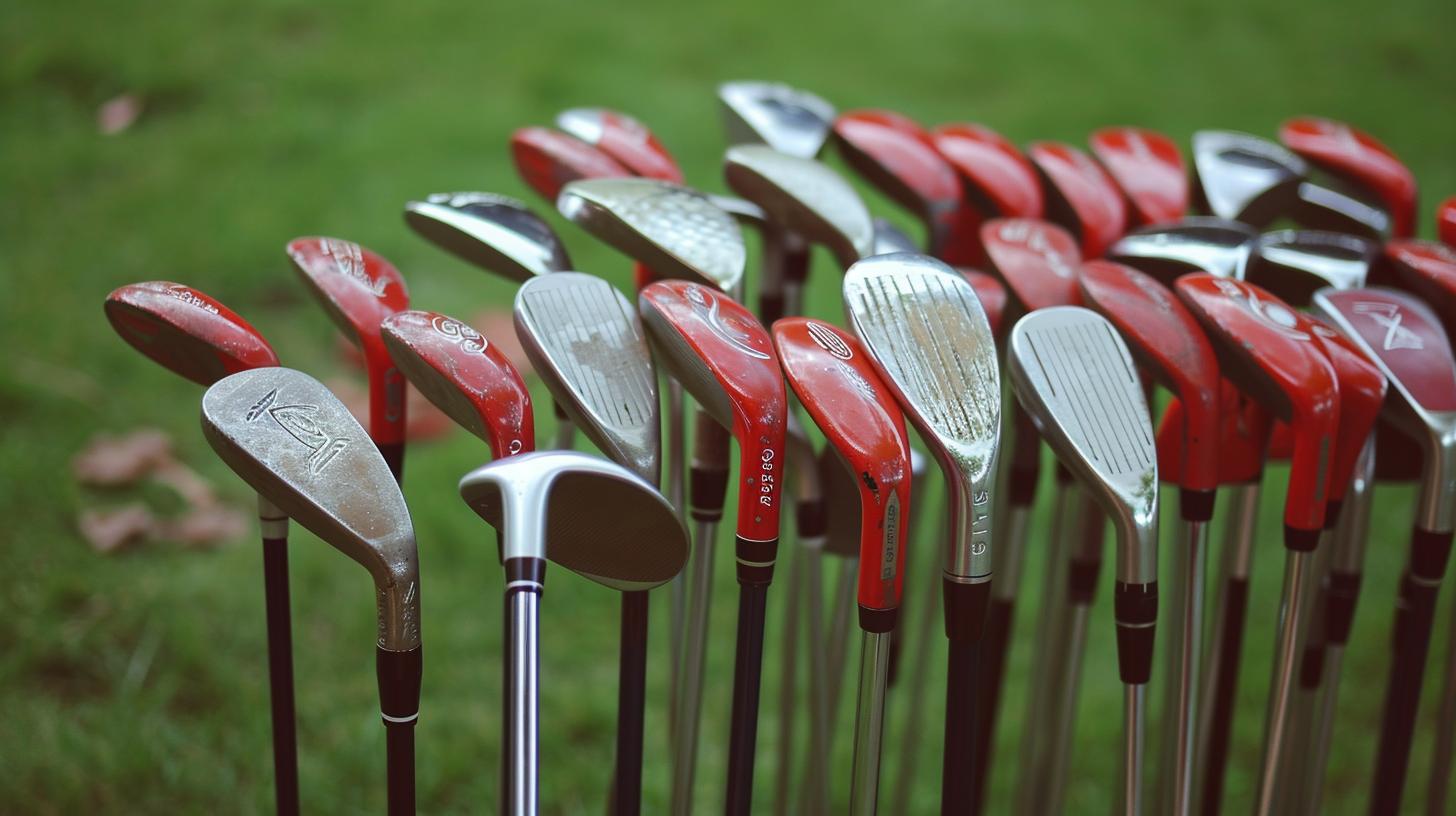
Golf clubs are essential tools for any golfer, and understanding the materials used in their construction is crucial to improving one’s game. The composition of a golf club can greatly impact its performance, feel, and playability on the course. In this article, we will delve into the various materials used in golf club manufacturing and explore their significant role in the sport.
The history of golf clubs dates back centuries, with early designs crafted from wood and other natural materials. Over time, advancements in technology and metallurgy have led to the evolution of golf club materials, resulting in a wide range of options available to today’s players. By tracing the origins of golf clubs and the materials used throughout history, we can better appreciate the innovations that have shaped modern-day club design.
Understanding the components of a golf club is essential for appreciating the role that different materials play in its construction. From the shaft to the grip, each part contributes to the overall performance of the club. This article will provide a comprehensive breakdown of these components and the materials typically used for each, offering valuable insights for both novice and experienced golfers alike.
History of Golf Clubs
The history of golf clubs is a fascinating journey that reflects the evolution of materials and technology in sports equipment. From the early days of hickory and persimmon wood to the modern era of high-tech alloys and composites, golf club materials have undergone significant changes.
1. Hickory and Persimmon: The earliest golf clubs were crafted from hickory wood, prized for its strength and flexibility. As the game advanced, persimmon wood became the material of choice for clubheads due to its durability and smooth texture. These wooden clubs were meticulously handmade by skilled craftsmen, reflecting the artisanal traditions of the sport.
2. Transition to Steel: The transition to steel as a primary material for golf club construction marked a pivotal moment in the history of golf equipment. The introduction of steel shafts and clubheads revolutionized the performance and durability of clubs, providing players with greater accuracy and distance.
3. Modern Innovations: In recent decades, graphite and titanium have emerged as leading materials in golf club design. Graphite shafts offer lightweight performance and enhanced flexibility, while titanium clubheads provide exceptional strength-to-weight ratio for maximum power and distance.
This historical overview illustrates how advancements in material science have continually reshaped the landscape of golf club design, enhancing the performance capabilities for players at every level. As we delve deeper into understanding the components and properties of different materials used in golf clubs, it becomes clear that each era has contributed unique innovations that continue to shape the game today.
Components of a Golf Club
Golf clubs are essential tools for any golfer, and understanding the materials used in their construction is crucial for maximizing performance on the course. The components of a golf club consist of the head, shaft, grip, and the various materials used for each part play a significant role in the overall feel and playability of the club.
The head of a golf club is typically made of steel, titanium, or graphite. Steel has been a traditional choice for club heads due to its durability and affordability. On the other hand, titanium is known for being lightweight yet strong, allowing for more forgiveness and distance. Graphite, while not as common for club heads, offers a unique blend of lightweight construction and flexibility that can enhance swing speed and power.
Moving on to the shaft, this component is also crucial in determining the performance of a golf club. Shafts are commonly made from steel or graphite. Steel shafts are known for their stability and control, making them popular among skilled golfers. On the other hand, graphite shafts are lighter and more flexible, providing greater distance with less effort.
Lastly, the grip of a golf club can be made from rubber, synthetic materials or leather. The material choice here impacts comfort, traction and shock absorption during each swing.
In summary, what are golf clubs made of? They can be crafted from an array of materials such as steel alloys, titanium, graphite composites and various synthetic grips. Having knowledge about these materials can help players make informed decisions when choosing golf equipment that suits their individual needs.
| Component | Materials |
|---|---|
| Club Head | Steel, Titanium or Graphite |
| Shaft | Steel or Graphite |
| Grip | Rubber, Synthetic Materials or Leather |
Steel Golf Clubs
Steel has been a traditional and popular material for the construction of golf clubs for many years. The use of steel in golf club manufacturing can be traced back to the early days of the sport, and it continues to be a prevalent choice among golfers. The durability and strength of steel make it an ideal material for creating clubheads, shafts, and other components of golf clubs.
One of the main advantages of using steel in golf club construction is its durability. Steel clubheads are known for their resilience and ability to withstand impact, making them suitable for long-term use on the golf course. Additionally, steel shafts provide stability and consistency in swing performance, which is highly valued by many golfers.
However, there are also drawbacks to consider when using steel golf clubs. Steel clubs tend to be heavier than those made from other materials such as graphite or titanium, which may affect swing speed and overall playability for some individuals. Furthermore, steel clubs may not offer the same level of vibration dampening as other materials, potentially leading to a less comfortable feel during impact with the ball.
When it comes to steel alloys used in golf club manufacturing, there are various options available with different compositions and properties. Manufacturers often utilize stainless steel or carbon steel alloys to create clubheads that offer specific characteristics such as forgiveness, distance, and control.
Understanding the nuances between different types of steel alloys can help golfers make informed decisions when selecting their clubs based on their playing style and preferences. Ultimately, weighing the pros and cons of using steel in golf club construction can help players determine whether this material aligns with their individual needs on the course.
Graphite Golf Clubs
When it comes to the materials used in golf clubs, graphite has become a popular choice for many golfers. Graphite golf clubs are known for their lightweight and flexibility, making them a preferred option for players looking to add more distance and speed to their swings. This section will dive into the properties of graphite as a material for golf clubs and compare and contrast its performance with steel clubs.
Graphite is a carbon-based material that is known for its strength and lightness. When used in golf club construction, graphite allows for the creation of larger clubheads and longer shafts without adding too much weight. This can result in increased swing speed and distance, making graphite clubs an attractive option for golfers looking to improve their performance on the course.
Compared to steel clubs, graphite shafts provide a different feel during the swing. The flexibility of graphite can result in a smoother impact with the ball, while steel shafts offer a firmer feel.
Additionally, graphite clubs are often favored by players who have slower swing speeds or those who prefer a lighter overall club weight. However, it’s important to note that while graphite offers advantages in terms of distance and speed, some players may find that they sacrifice a bit of control compared to steel clubs.
Titanium Golf Clubs
The Rise of Titanium in Golf Club Design
In recent years, titanium has emerged as a popular choice for golf club manufacturing due to its unique properties and benefits. Titanium is known for being lightweight yet incredibly strong, making it an ideal material for creating clubs that combine power and precision. The use of titanium in golf clubs has revolutionized the way players approach their game, offering a range of advantages that have propelled its popularity among golfers of all levels.
Characteristics and Benefits of Titanium Clubs
Titanium golf clubs are highly sought after for their durability, allowing players to achieve consistent performance over time. The material’s strength-to-weight ratio also enables the design of clubs with larger head sizes, providing a larger “sweet spot” for improved forgiveness and distance on off-center hits.
Additionally, the lightweight nature of titanium allows for greater clubhead speed, resulting in increased ball velocity and enhanced distance down the fairway. These characteristics make titanium clubs particularly appealing to players looking to maximize their power and accuracy on the course.
Titanium vs. Steel Clubs
When comparing titanium with steel clubs, it becomes evident that each material offers distinct advantages that cater to different playing styles. While steel may provide a more traditional feel and responsiveness, titanium excels in terms of forgiveness and distance.
Ultimately, the choice between these materials comes down to personal preference and performance objectives. Both materials have their own set of strengths and weaknesses, making it essential for golfers to understand how their individual game can benefit from the specific attributes offered by each material.
With the prevalence of titanium in modern golf club design, it is clear that this material will continue to play a significant role in shaping the future of golf equipment technology. As advancements in materials science continue to drive innovation within the industry, golfers can look forward to even more exciting developments that push the boundaries of performance and enhance the overall playing experience.
Other Materials Used in Golf Clubs
Golf club materials have come a long way from the traditional wooden and metal clubs used in the early days of the sport. In addition to steel, graphite, and titanium, there are other alternative materials that are being used in modern golf club construction. These alternative materials include composites, ceramics, and other advanced substances that offer unique properties and benefits for golfers.
Composite materials, which are made from a combination of different substances such as carbon fiber, fiberglass, or resin, offer a lightweight yet durable option for golf clubs. These materials allow for greater design flexibility and the ability to fine-tune specific performance characteristics of the club.
Ceramics have also emerged as a potential material for golf clubs due to their exceptional strength and hardness. While not as widely used as steel or graphite, ceramic clubs offer potential advantages in terms of durability and impact resistance.
Furthermore, advancements in technology have paved the way for the development of golf clubs using other advanced materials such as polymers and nanomaterials. These cutting-edge substances provide new opportunities for enhancing club design and performance in ways that were previously not possible with traditional materials alone.
Overall, the use of alternative materials in golf club construction represents an ongoing trend towards innovation and customization in the sport. As technology continues to advance, golfers can expect to see even more diverse and specialized options for club materials that cater to different playing styles and preferences. It is important for players to stay informed about these developments so they can make well-informed choices when selecting their golf equipment.
The Impact of Material on Golf Club Performance
Golf club performance is greatly influenced by the materials used in their construction. The choice of material can affect the club’s feel, playability, and overall performance on the course. Understanding how different materials impact golf club performance is crucial for players looking to improve their game.
Weight and Durability
One of the most important factors affected by the material of a golf club is its weight and durability. Steel clubs, for example, are known for their durability and ability to withstand wear and tear over time. On the other hand, graphite clubs are lighter in weight, allowing for increased swing speed and distance. Titanium clubs offer a good balance between strength and lightness, making them a popular choice among golfers.
Flexibility and Impact on Ball Flight
The flexibility of a golf club also varies depending on its material. Steel clubs tend to be stiffer, providing more control over ball flight and shot direction. Graphite clubs, on the other hand, offer more flex, allowing for greater distance and forgiveness on off-center hits. Understanding how these different materials affect flexibility can help golfers choose the right clubs for their playing style.
Feel and Feedback
The feel of a golf club in hand is crucial for many players when making shots. The material of the club greatly impacts this aspect as well. Steel clubs are known for their solid feel at impact, providing immediate feedback to the golfer. Graphite clubs offer a softer feel that some players prefer, while titanium clubs provide a unique combination of solid impact feel with lightweight design.
Overall, understanding how different materials impact golf club performance is essential for every golfer looking to enhance their game. By considering factors such as weight, durability, flexibility, impact on ball flight, and overall feel and feedback when choosing golf clubs made from different materials players can optimize their equipment to fit their individual playing style and preferences.
Conclusion
In conclusion, the materials used in golf club construction play a crucial role in the performance and feel of the clubs. Throughout history, golf clubs have evolved from wooden shafts and leather grips to modern, high-tech materials such as steel, graphite, and titanium. Understanding the different properties and characteristics of these materials is essential for selecting the right clubs that match your individual playing style and preferences.
The history of golf club materials has seen significant developments and innovations, with each material offering unique advantages and disadvantages. Steel has long been a standard material for club heads and shafts due to its durability and affordability, while graphite has gained popularity for its lightweight properties and ability to dampen vibrations. Additionally, titanium has become increasingly popular for its strength-to-weight ratio and ability to create larger club faces for improved forgiveness on off-center hits.
When considering what are golf clubs made of, it’s important to recognize that the material used not only impacts the performance of the club but also influences how it feels in your hands. Whether you prefer the solid feedback of steel or the responsiveness of graphite, choosing the right material can enhance your overall playing experience on the course.
By understanding and considering the diverse range of materials available in today’s golf clubs, players can make informed decisions that will ultimately improve their game.






